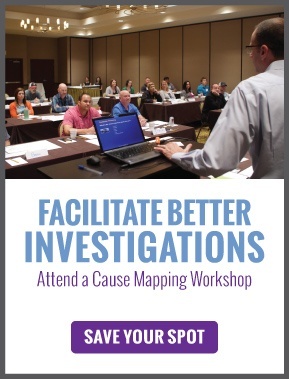Companies sometimes make a problem worse by how they respond to it. The initial problem wasn’t good, but now the consequences are even larger. Some people refer to this situation as turning a headache into a heart attack. The “We Made It Worse” Cause Map points out how our response to an issue can make the outcome much worse. This Cause Map is a parallel cause-and-effect relationship with two causal paths. One path is the original issue (the headache) and the other path is the ineffective response (which turns into the heart attack).

Why Questions on Both Paths
To fully understand how this happens, the investigation must ask why questions for both paths. It’s important to understand why the original issue occurred, as well as why the response wasn’t effective. There is insight down each path. You need to ask the question – Why did that happen?
Omitting Details, Omits Solutions
 Organizations may not want to call attention to these types of situations. Disclosing an “uh-oh” (or a few of them) is not always appealing. Management is unaware of the detail people don’t share. The analysis will be simpler, but it will also be incomplete. That three-day outage will be attributed solely to the equipment failure. The poor response isn’t even part of the explanation to management – it’s been omitted. Leaving out details from the analysis removes the opportunity to identify better solutions. The equipment failure is not the only cause of the three-day outage – it’s just one of them. A Cause Map can begin as a simple straight line, then expand into as much detail as needed to thoroughly explain an issue.
Organizations may not want to call attention to these types of situations. Disclosing an “uh-oh” (or a few of them) is not always appealing. Management is unaware of the detail people don’t share. The analysis will be simpler, but it will also be incomplete. That three-day outage will be attributed solely to the equipment failure. The poor response isn’t even part of the explanation to management – it’s been omitted. Leaving out details from the analysis removes the opportunity to identify better solutions. The equipment failure is not the only cause of the three-day outage – it’s just one of them. A Cause Map can begin as a simple straight line, then expand into as much detail as needed to thoroughly explain an issue.
Dig into the Details
The next Cause Map shows how the three-day outage consists of one day of downtime due to the equipment failure and two additional days of downtime because the repair was not ideal. Like the heart attack Cause Map, both paths can be investigated further by asking a few simple why questions. If we could have avoided adding two days to the repair, the outage would have been one day, not three. These lessons are essential for an organization to understand how to reduce risk.
Even in cases where the response was ideal (meaning it went well), a complete investigation can reveal why it went well, so those steps can be repeated the next time. A Cause Map can explain why things went poorly, as well as why they went well. Both scenarios provide valuable insight within a company.

Learn these Skills
To learn more about applying cause-and-effect thinking to your problems watch one of our free 30-min webinars or attend our three-day public workshop. ThinkReliability instructors also present workshops at your site where your team can begin applying the Cause Mapping method of root cause analysis to their actual problems.











